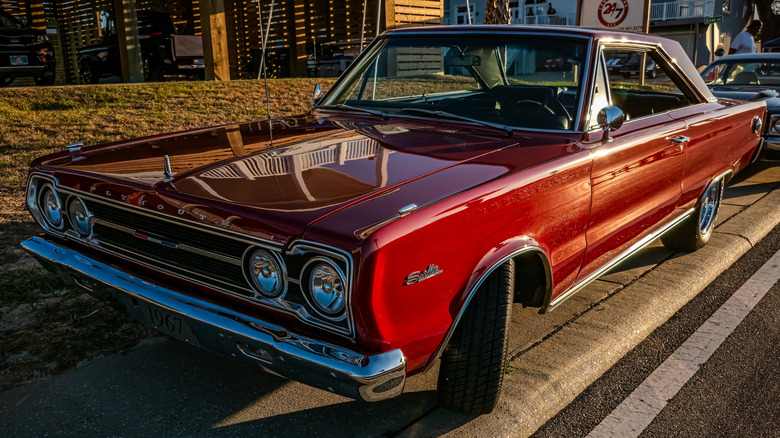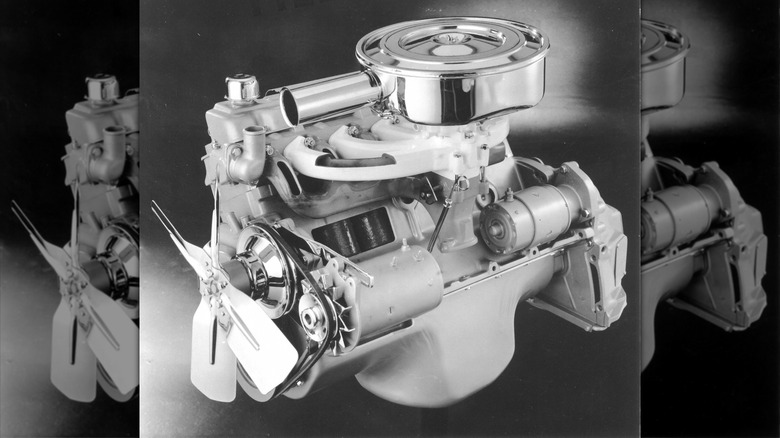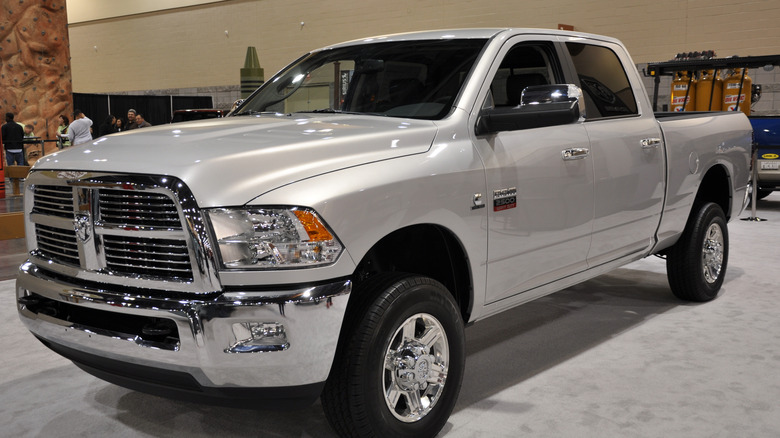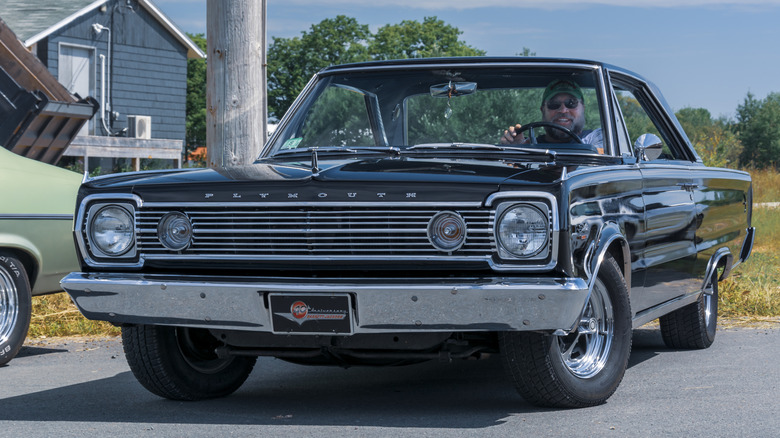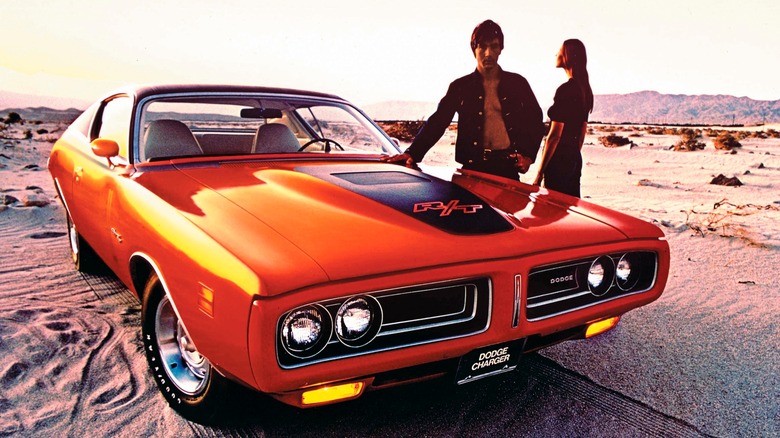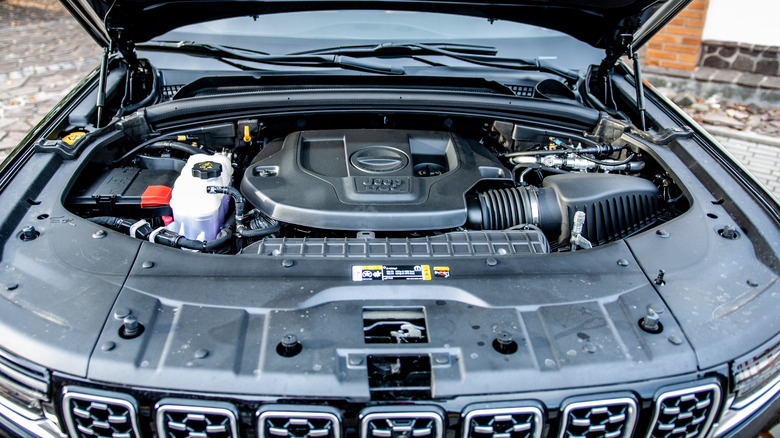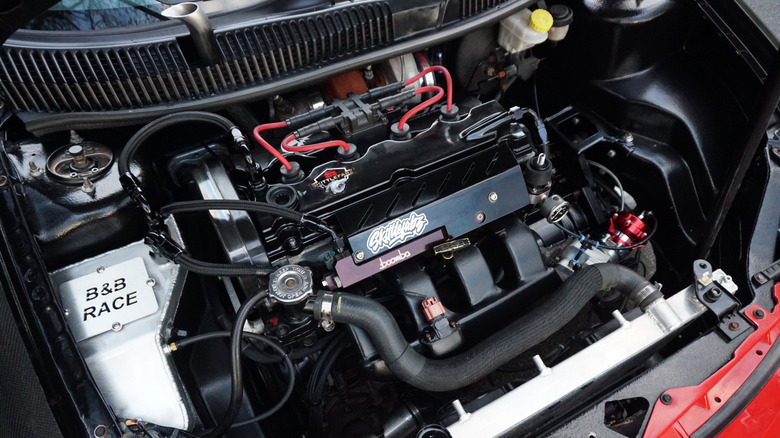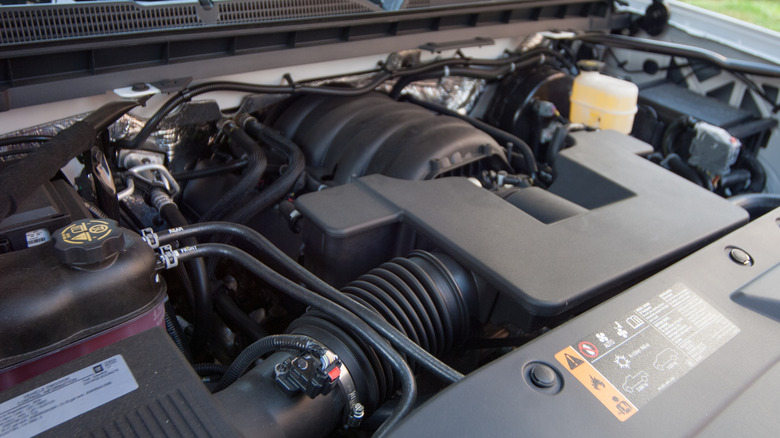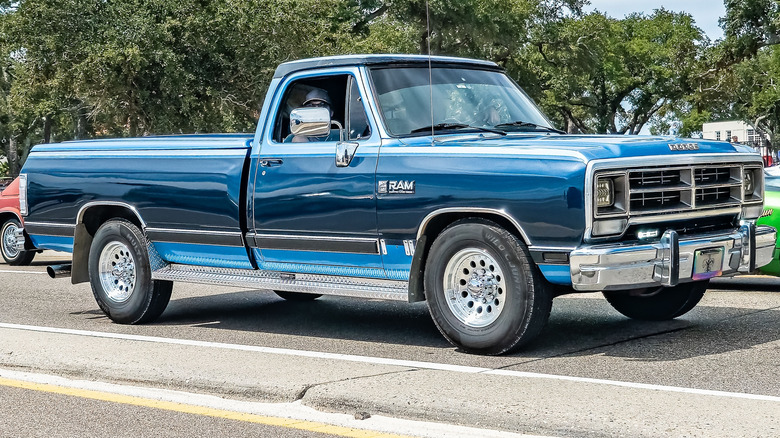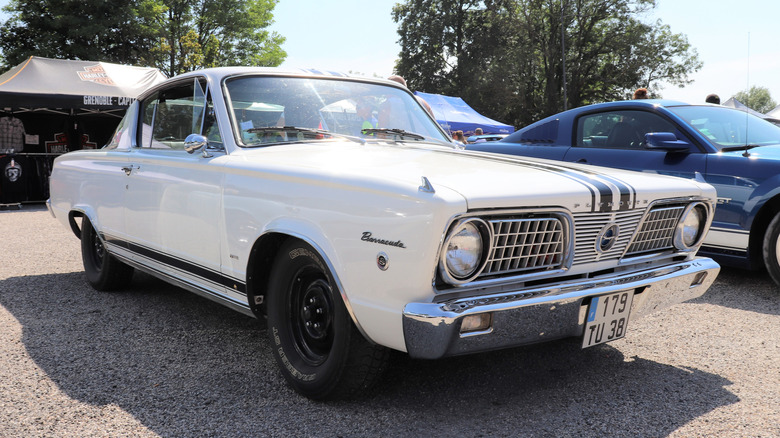8 Of The Most Reliable Chrysler Engines Ever Made
We may receive a commission on purchases made from links.
Walter Chrysler's first Chrysler-branded car debuted a century ago in the form of the 1924 Chrysler Six, also known as the B70. With a high-compression six-cylinder engine that could easily propel the car to speeds of 70 MPH and above–very impressive for that time period–it established Chrysler's performance reputation right out of the gate. Since then, the Chrysler Corporation has made a name for itself with powerful engines like its legendary Hemi line that first appeared in 1951. However, less attention has been paid to the reliability of its motors.
From the beginning, Chrysler has been geared toward being an everyday driver. Its earliest customers were on the wealthier side, and they didn't expect to take off their cufflinks and roll up their sleeves to work under the hood on the way to the office. So the company's engineering philosophy has always sought to balance performance with dependability, whether in a modest V6 Chrysler or Plymouth family sedan, a cargo-hauling Dodge or Ram diesel pickup, a trail-busting Jeep, or a fire-breathing Hemi muscle car.
225 Slant Six
When old-timers wax eloquent about bulletproof Chrysler engines, there's a good chance they're referring to the Slant Six. This inline six-cylinder powerplant proved so reliable that it served as a mainstay of Chrysler's engine lineup from 1960 all the way to 1987. Efficient and easy to work on, it gave Chrysler a potent response to imports, which had grown in popularity through the 1950s.
The Slant Six got its unusual name from the 30-degree angle at which it was mounted in the engine bay. This radical design earned the motor's nickname — the Leaning Tower of Power. It also enabled designers to fit it beneath the hood of low-profile designs. Yet despite the engine's odd tilt, its major components were still easy to reach, making the Slant Six a breeze to work on.
The Slant Six first appeared under the hood of the 1960 Plymouth Valiant, but would soon spread to the entire stable of Chrysler brands. In the Valiant, this first version of the engine produced 101 horsepower from 170 cubic inches of displacement. Torque was a more respectable 155 lb-ft.
Larger versions including the 225 cubic-inch edition soon followed with longer strokes and more horsepower, and Mopar add-ons delivered solid performance. Still, reliability is what made the Slant Six legendary. In fact, a 1969 Dodge Dart with the Slant Six reached 430,000 miles with just regular maintenance.
4.7-liter Powertech V8
For drivers who wanted V8 power without stopping at the gas pump every few days, the 4.7-liter PowerTech V8 supplied the answer. Available in the Chrysler Aspen SUV and several Dodge and Jeep pickups and SUVs between 1999 and 2013, the Powertech could last hundreds of thousands of miles as long as its owner was faithful about getting oil changes.
The PowerTech was a clean sheet of paper design featuring a 3.66-inch bore and a 3.4-inch stroke in a cast iron block, along with an overhead camshaft, cast aluminum cylinder heads, and sequential multi-port fuel injection. This was a two-valve-per-cylinder design, with semi-hemispherical combustion chambers. The latter fact, along with some mechanical bits borrowed from the 5.7-liter Hemi starting in 2008, helped earn this motor the nickname of Semi-Hemi.
In its initial version with a 9.0:1 compression ratio, horsepower was a relatively modest 235 horses, although 295 lb-ft of torque made it a useful towing vehicle. By 2008, the compression ratio had increased to 9.8:1 and the PowerTech generated as much as 310 horsepower in some models along with 334 ft-lb of torque.
Its relative mechanical simplicity made it an easy engine to maintain. Maintenance is key with the PowerTech — this is a rugged workhorse of an engine, but regular oil changes are a must to prevent sludge build-up. As long as its owner faithfully sticks to the maintenance schedule, though, the PowerTech should easily reach 200,000 miles.
426 Hemi V8
In the muscle car era, some engines were built for top speed and endurance on the track but weren't ideal for everyday driving. By contrast, the 426 Hemi in street models was designed specifically for easier driving and long-term reliability. While it never ended up in a Chrysler-branded car, the 426 Hemi engine street version powered a number of Dodge and Plymouth models starting in 1966.
The version installed in these models was known as the Street Hemi, in contrast to the racing engine from which it was derived. The Street Hemi resulted from racing homologation rules which required a certain number of street versions of Dodge's race cars. Fewer than 10,000 426 Street Hemis were ever sold to the public, and as such it's one of the most collectible engines of all time.
Officially, the 426 Hemi cranked out 425 horsepower along with a tire-shredding 490 lb-ft of torque. The street-legal version was detuned slightly from the race version to achieve more usable around-town power, with its compression ratio reduced to 10.25:1 from the racer's stratospheric 12.5:1. Other changes to the camshaft, cylinder heads, timing, and exhaust also made it a more civilized daily driver.
As for reliability, the Hemi engine family is generally reliable within the context of high-performance engines and most can achieve six-digit mileage. If owners stay alert for the well-known "Hemi tick" and get it fixed right away, a vintage 426 Hemi should keep driving for another generation.
440 RB V8
One of the best Chrysler Mopar 440ci V8 engines was the 440 RB (Raised Block) which delivered both power and reliability. This engine became a mainstay throughout Chrysler's brands from 1966 to 1978. Not only did it appear in muscle car legends like the Challenger and the Road Runner Superbird, but over the course of its production run it appeared in sedans, pickups, and other unlikely vehicles.
This 440-cubic-inch beast evolved from Chrysler's 383-cubic-inch big block. Its larger displacement resulted from lengthening the piston stroke from 3.375 inches to 3.75 inches. This also meant that the engine's deck height had to be increased, thus resulting in the Raised Block moniker.
Unlike Chrysler's Hemi engines with their famous hemispherical combustion chambers, the 440RB had wedge-shaped chambers, giving it the additional nickname of wedge motor. The head design was less complex and less expensive to build than the typical Hemi, resulting in the 440 RB becoming a more common engine choice. A triple-carburetor option called the Six Pack offered 15 extra ponies from 1969 through 1971.
Ultimate horsepower may not have been equal to the most famous Hemi engines, but the simpler design resulted in greater reliability as an everyday driver. Motor Trend says, "when it comes to a combination of torque, power, and drivability, the 440 ranks as one of the best engines ever built." It was even used in motor homes, where some racked up hundreds of thousands of miles without major issues.
3.6-liter Pentastar V6
Some powerplants trade maximum levels of excitement for reassuring dependability, and the 3.6-liter Pentastar engine is a prime example. You'll find it under the hood of family transporters like the Chrysler Pacifica and Town & Country minivans and the Chrysler 200 sedan, as well as Ram trucks, Dodge cars, and Jeeps, from 2011 through the present. They're even used in foreign cars manufactured by Lancia and Fiat, the Italian divisions of Chrysler's current owner, Stellantis.
Its popularity results from its efficiency and reliability. Power is good for a V6, too, ranging between 283 and 305 depending on the model. It's significantly gutsier than the 3.5-liter V6 that it replaced. In a typical application of the Pentastar V6, namely the 2016 Chrysler 200 sedan, this motor generated 295 horsepower while achieving 32 MPG on the highway. Reviewers found it reasonably fun to drive, too, with more acceleration than they generally expected.
The Pentastar features a cast aluminum block for light weight but also has cast-iron cylinder liners for durability. Plus, it sports an open-deck design, which lowers manufacturing costs and increases cooling efficiency. Maintenance is simple for a modern engine, and this ease of maintenance contributes to the Pentastar's reliability. More than 10 million Pentastars have been built, and one Pentastar even reached 626,000 miles.
2.4-liter SRT-4 Turbo Inline 4
Strictly speaking, the name SRT-4 applies to the cars in which this engine appeared–the 2003 to 2005 Dodge Neon SRT-4 and the 2008 Dodge Caliber SRT-4–rather than to the engine itself. However, this engine became something of a legend in the early to mid 2000s decade, when compact performance cars surged in popularity. Enthusiasts looking for an underrated Dodge model for their garages were drawn to the Neon SRT-4.
This turbo terror was based on a naturally aspirated 2.4-liter, dual-overhead cam motor that only created between 132 and 150 horsepower, depending on the trim levels of the cars it was installed in. To boost this number, Dodge bolted on an intercooled Mitsubishi turbocharger. This bumped horsepower up to a much more exciting 215 for 2003. With tweaks to the fuel injection and other components, that number jumped to 230 horsepower in 2004 and 2005.
This gave the lightweight Neon a horsepower-to-weight ratio higher than that of some of the legendary muscle cars of the 60s, and its performance reflected that. It ran from 0 to 60 MPH in only 5.6 seconds, while suspension upgrades like front and rear anti-roll bars gave it great handling.
Owners of used Neon SRT-4s on Edmunds give the 2004 model 4.8 stars out of 5, and they give the 2005 model 4.7 stars out of 5. Many of the reviews rave about its reliability, so clearly this model hit the sweet spot for balancing performance with everyday usability.
5.7-liter Hemi V8
Introduced in 2003, and still available to buy new in Hemi-powered cars through 2024, the 5.7-liter Hemi has long lived in the shadow of its 6.4-liter big brother. While some models that have previously provided a home for this engine are going electric, the 5.7-liter Hemi soldiers on in Ram and Jeep models.
Chrysler revived the fabled Hemi name in 2003 Dodge Ram pickups. It would go on to serve in the Chrysler 300C as well as a number of Dodge cars and Jeep SUVs, eventually becoming the base V8 option. The 5.7-liter is also sometimes referred to as the 345 Hemi. Horsepower ranges between 340 and 395, depending on the year and model.
The 5.7-liter has a cast-iron block while featuring aluminum pistons. The current generation of Hemi has its namesake hemispherical combustion chambers slightly flattened at the top, causing some purists to argue that it's not a real Hemi. Yet this motor still captures the power and efficient combustion of the bowl-shaped chambers, just like its famous muscle-car era ancestors.
Owner reviews show how reliable the 5.7-liter Hemi engine is. As in other Hemis, one thing to stay on top of is the easily-fixed Hemi tick. Take care of that and do regular maintenance, and owners say the engine can last well into six-figure mileage. One member of the Allpar owner's club even reports that his million-mile 2004 Dodge Ram made it to 606,000 miles with its original 5.7-liter Hemi.
5.9-liter Inline-six Cummins Diesel
While the 5.9-liter Cummins diesel engine won't be found under any Chrysler-badged passenger cars, it did appear in trucks from Chrysler Corporation's Dodge division, and it would be a mistake not to include it in a list of reliable engines from Chrysler. Trucks need engines that can run for decades without major issues, and this diesel legend delivered. From 1989 to 2007, the 5.9-liter Cummins delivered power and dependability until it was succeeded by a 6.7-liter version.
The earliest version of the 5.9-liter debuted in 1989 with two valves per cylinder, direct injection, and a turbocharger, good for 160 horsepower and 400 lb-ft of torque. By the standards of the time, this made the Dodge Ram a class leader. Plus, more horsepower and torque arrived in 1998 with the introduction of electronic engine management and four valves per cylinder, boosting horsepower to 325 and torque to 610 lb-ft.
Cummins, Inc. has built diesel engines in collaboration with the engineers at Chrysler/Stellantis ever since that first Cummins-powered Dodge Ram in 1989. Cummins also builds diesel engines for a wide range of demanding applications, from campers to generators to ship engines. Their reputation for reliability drew throngs of buyers to Dodge trucks right from the start of the partnership.
How reliable is the 5.9-liter Cummins diesel? Cummins actually has a High Mileage Club whose members receive a badge for every 100,000 miles that tick over on their odometers. In fact, one member of the club currently has over a half million miles and counting.
Why did we choose these Chrysler engines?
Chrysler has a long history of engineering innovation. We chose these engines to represent a spectrum from across several decades, focusing primarily on motors available in Chrysler's flagship division, but also acknowledging the importance of its Plymouth, Dodge, Ram, and Jeep divisions.
We also selected engines from a variety of niches, from a high-performance four-cylinder to V6 motors in family-oriented vehicles to king-of-the-hill high-performance engines like Hemis. After all, no discussion of engines from Chrysler or any of its divisions would be complete without mentioning its cars' popularity with everyday drivers as well as its racing-inspired muscle-car heritage.
